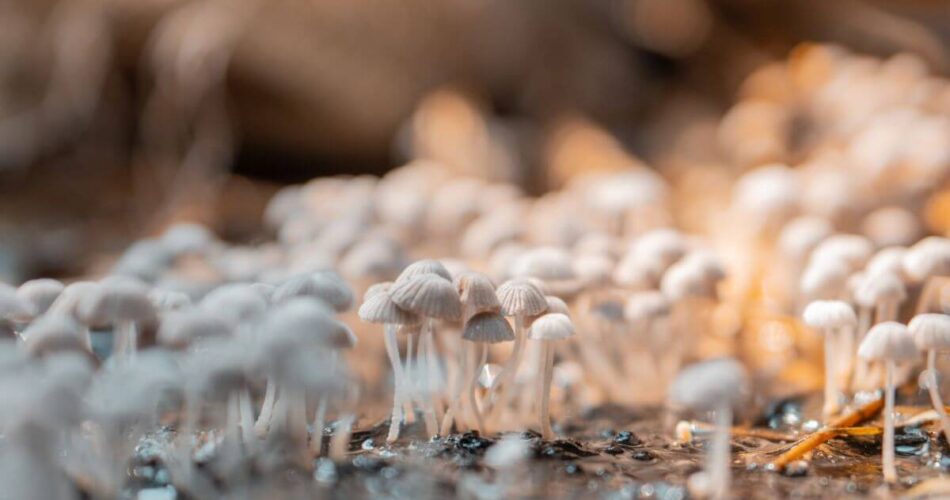Have you ever seen a rusty mushroom before? If not, you may be surprised to know that there’s a wild mushroom out there that sports this colorful hue. The Gymnopilus aeruginosus, known as the magic blue gym, is a common fungus found throughout North America.
While it’s not particularly popular, this odd-looking mushroom does have its share of fans among mushroom hunters. So what makes the Gymnopilus aeruginosus so special? Keep reading to find out!
Gymnopilus Aeruginosus – History
Gymnopilus aeruginosus is a species of fungi in the family Cortinariaceae. It was first described by mycologist Johann Heinrich Friedrich Link in 1809 as Agaricus aeruginosus. Its current name Gymnopilus Aeruginosus was given in 1951 by famous mycologist Rolf Singer.
The type locality is the Pacific Northwest, but it can be also found in Asia and some of the southern states. The other name for this species is Rusty Grilled Fungus.
Habitat of Gymnopilus Aeruginosus
This fungus is quite common in America and Europe, where it can be found growing on deciduous trees, especially oak and beech. It has also been reported from Asia. Gymnopilus Aeruginosus usually grows in clusters on dead wood and wood chip mulch. The fruit bodies of this fungus produce a rusty brown spore print.
This species is sometimes confused with Gymnopilus luteofolius, which has a more orange cap and paler gills, and Gymnopilus junonius, which has a more orange cap and darker gills.
Gymnopilus Aeruginosus – Morphology
The fruit bodies of G. aeruginosus are large, with caps up to 10 cm (4 in) in diameter. The caps are initially convex, but later flatten out and may have a slightly depressed center. The cap surface is dry, with a powdery or hairy texture, and is rusty orange to rusty brown in color. The gills are adnexed to adnate or slightly emarginate, and are yellowish to reddish in color. The spores are hyaline, and measure 7–9 by 4–5 µm. It has bitter taste.
Is Gymnopilus Aeruginosus a Magic Mushroom?
Gymnopilus aeruginosus has been used as a traditional medicine in some cultures. It is also known to contain the compounds psilocybin and psilocin, which are psychoactive compounds that can produce hallucinations. Because of this, G. aeruginosus has been considered a “magic mushroom” in some circles. However, there is no scientific evidence to support this claim.
Is Gymnopilus Aeruginosus Edible?
While this mushroom is edible, it is not considered to be a desirable food source due to its small size and bland taste. Additionally, some people may experience gastrointestinal upset after consuming this mushroom. Therefore, it is recommended that you consult with a knowledgeable Mushroom Hunter or Mycologist before consuming any mushrooms that you are unfamiliar with. Due to psilocybin – a psychoactive compound – it can cause hallucinations and other psychedelic effects.
How to Identify Gymnopilus Aeruginosus
Gymnopilus aeruginosus is a type of mushroom that belongs to the Gymnopilus genus. This mushroom is also commonly known as the rusty-gilled coprinus. It is characterized by its brown to reddish-brown cap, which has a diameter of about 2-8 centimeters. The gills of this mushroom are also brown to reddish-brown in color, and they are located close to the stem. The spores of this mushroom are white in color.
This mushroom is found growing on wood debris, logs, stumps, and trees. It typically grows in clusters or groups. The mushrooms in this group can be found in North America, Europe, Asia, and Australia.
Picking Up Shrooms – Safety Rules
If you’re planning on picking mushrooms in the wild, it’s important to know which ones are safe to eat and which ones aren’t. Here are some general rules to follow:
- Only pick mushrooms that you know for sure are safe. If you’re not sure, don’t risk it.
- Avoid picking mushrooms that are growing in areas that may have been sprayed with pesticides or other chemicals.
- Don’t pick mushrooms that are growing near power lines or other sources of electromagnetic radiation.
- Be sure to wash your hands and any equipment you use for mushroom picking before consuming or preparing any mushrooms.
Similar Posts:
- Gymnopilus Luteus Mushroom – Description, Habitat, How to Identify the Species
- Gymnopilus Luteofolius – Spore Print, Description, Habitat, etc. Learn About This Unique Fungus
- Gymnopilus Viridans: Uncommon Shrooms Species
- Gymnopilus Purpuratus. All You Need to Know About This Magic Mushroom Species
- Psilocybe Bohemica: A Psilocybin Mushroom From Europe. All the Information You Need to Know About the Species
- Gymnopilus Validipes: All You Should Know About Magic Mushroom Species
- Gymnopilus Luteoviridis Mushrooms: A Complete Guide




